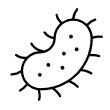
Microplastics (MP) encompass plastic particles ranging in size from 1 nanometer to 5 millimeters. MP historically appeared in lotions and creams as “microbeads,” which acted as exfoliants. MP also form through different processes including the gradual degradation of larger plastic items over time, which results in the generation of progressively smaller plastic particles. Additionally, textiles and synthetic clothing can form MP from daily wear and tear.
No matter the source, MP have been detected in disparate regions such as Arctic snow, deep ocean waters, Alps air and drinking water. Although significant gaps currently exist in our knowledge of the health effects of MP, environmental professionals are becoming increasingly aware of the potential environmental impacts. Due to their extended lifespan lasting several centuries, MP possess the capacity to amass within various ecosystems, subsequently being ingested, inhaled and assimilated by ecological receptors. Animals ranging from turtles to whales to humans have been found to have MP in their stomachs, blood or lungs. MP consumption may increase risk of health problems like reproductive issues, decreased immune system functioning and inhibited breathing. As it becomes apparent that MP impacts pose a risk to human health and the environment, researchers are actively exploring creative and novel solutions to address the issue.
Microplastic Reduction
Reducing the future release of MP to the environment is essential. Some reduction tactics include
- Reducing the production of plastics by material substitutions (e.g., switching to natural materials such as paper, cotton or metal);
- Reducing or eliminating access to single-use plastic products; and
- Improving our ability to reuse and recycle existing plastic products.
Achieving some level of reduction in plastic use is the most effective way to limit MP pollution, as this will reduce the volume of MP accumulating in the environment.
Removing MP from the Environment: Innovative Remedial Concepts
The Interstate Technology and Regulatory Council’s (ITRC) “Microplastics” guidance document contains an extensive list of both established and emerging treatment technologies for a variety of media in its “Mitigation and Abatement” section. Worldwide, there are also many pioneering MP remediation technologies currently being tested and more will likely emerge in the coming years. The remedial concepts highlighted below represent innovative approaches from across the globe aiming to address MP contamination by utilizing key characteristics such as hydrophobicity, density and static reaction.
Tire Particle Catcher
![]() The process of vehicle tires colliding with the ground generates tire wear particle dust that impact a wide variety of media including air, soil, surface water and sediment. A novel technology being tested in the UK attaches to car tires and utilizes electrostatics to collect the dust particles emitted by the spinning tire. The particles are caught and stored and could potentially be upcycled.
The process of vehicle tires colliding with the ground generates tire wear particle dust that impact a wide variety of media including air, soil, surface water and sediment. A novel technology being tested in the UK attaches to car tires and utilizes electrostatics to collect the dust particles emitted by the spinning tire. The particles are caught and stored and could potentially be upcycled.
Biofilm Clumps
 This potential solution utilizes bacteria to remove MP from aquatic systems. Bacteria often clump to each other and other surfaces, which frequently form adhesive structures known as biofilms. Researchers at Hong Kong Polytechnic University hypothesize that biofilms could be used to create microbial nets to remove MP from water. The sticky surfaces of the bacteria clumps would attract the MP and ensnare them. The biofilm net could then be removed from the water and be recycled or disposed of in a controlled facility.
This potential solution utilizes bacteria to remove MP from aquatic systems. Bacteria often clump to each other and other surfaces, which frequently form adhesive structures known as biofilms. Researchers at Hong Kong Polytechnic University hypothesize that biofilms could be used to create microbial nets to remove MP from water. The sticky surfaces of the bacteria clumps would attract the MP and ensnare them. The biofilm net could then be removed from the water and be recycled or disposed of in a controlled facility.
Clumping Silica Whirlpools
 A German company is working on a similar concept to clump/remove MP in water. They mix a silica-type gel, which they have named Wasser 3.0 PE-X, into a water tank and create a vortex to clump the MP in the water column. The resulting clumps float and can be easily removed from the surface of the water within the tank for disposal or recycling.
A German company is working on a similar concept to clump/remove MP in water. They mix a silica-type gel, which they have named Wasser 3.0 PE-X, into a water tank and create a vortex to clump the MP in the water column. The resulting clumps float and can be easily removed from the surface of the water within the tank for disposal or recycling.
Egg White Aerogel
 Princeton researchers created an aerogel out of egg whites to filter MP out of water. The aerogel was created by freeze drying then heating the egg whites in an anaerobic environment to create the porous aerogel media, which is comparable to granular activated carbon. The resulting aerogel was 99% effective at removing MP from seawater.
Princeton researchers created an aerogel out of egg whites to filter MP out of water. The aerogel was created by freeze drying then heating the egg whites in an anaerobic environment to create the porous aerogel media, which is comparable to granular activated carbon. The resulting aerogel was 99% effective at removing MP from seawater.
Free Radical Nanocoils
 Nanocoils are very small, reusable reactors that can trigger MP breakdown. They are made from combining magnesium with a carbon nanotube. The nanocoils generate free radicals that cause reactions with the MP, breaking them down in size, and ideally resulting in end products of carbon dioxide and water. Researchers at Adelaide University have achieved breakdown rates of 50% of MP to carbon dioxide and water by heating the aqueous solutions to high temperatures to encourage reactions.
Nanocoils are very small, reusable reactors that can trigger MP breakdown. They are made from combining magnesium with a carbon nanotube. The nanocoils generate free radicals that cause reactions with the MP, breaking them down in size, and ideally resulting in end products of carbon dioxide and water. Researchers at Adelaide University have achieved breakdown rates of 50% of MP to carbon dioxide and water by heating the aqueous solutions to high temperatures to encourage reactions.
Plastic-Attacking Enzymes
 Enzyme variants created by researchers at The University of Texas at Austin, named FAST-PETase, have also been found to expedite plastic degradation rates. The enzymes attack polyethylene terephthalate (PET), a common consumer packaging polymer, breaking it down into multiple smaller polymers and then chemically putting it back together (depolymerization/repolymerization). Importantly, high temperatures are not required to achieve breakdown, making this option more viable in real-world environments.
Enzyme variants created by researchers at The University of Texas at Austin, named FAST-PETase, have also been found to expedite plastic degradation rates. The enzymes attack polyethylene terephthalate (PET), a common consumer packaging polymer, breaking it down into multiple smaller polymers and then chemically putting it back together (depolymerization/repolymerization). Importantly, high temperatures are not required to achieve breakdown, making this option more viable in real-world environments.
Hydrocyclone
 This concept relies on centrifugal forces within a conical structure to remove MP that are free floating in water. As the MP-containing aqueous solution spins around the perimeter of the cone, the plastic particles migrate to the edges of the cone and flow downward into a collection basin, while the water can be decanted or pumped off the top of the cone (Seavax). This concept would likely work best with larger and/or denser MP, which would be more likely to drop out of solution. This method could also have the potential to be implemented at dredging projects, where sediment and water could be removed in combination and then separated and treated for MP.
This concept relies on centrifugal forces within a conical structure to remove MP that are free floating in water. As the MP-containing aqueous solution spins around the perimeter of the cone, the plastic particles migrate to the edges of the cone and flow downward into a collection basin, while the water can be decanted or pumped off the top of the cone (Seavax). This concept would likely work best with larger and/or denser MP, which would be more likely to drop out of solution. This method could also have the potential to be implemented at dredging projects, where sediment and water could be removed in combination and then separated and treated for MP.
Bubble Barrier
 The Great Bubble Barrier works to intercept plastic waste before it reaches the ocean. A perforated tube is laid diagonal to surface water flow on the bottom of the waterway. Air pumped through the tube creates a “bubble curtain” whose upward current forces MP to the water surface. The diagonal orientation directs plastics into a catchment system at the bank of the waterway where it can be captured and removed from the water. Bubble barriers allow fish and ship traffic to continue, helping to prevent disruptions to biodiversity and the economy, while promoting cleaner waterways.
The Great Bubble Barrier works to intercept plastic waste before it reaches the ocean. A perforated tube is laid diagonal to surface water flow on the bottom of the waterway. Air pumped through the tube creates a “bubble curtain” whose upward current forces MP to the water surface. The diagonal orientation directs plastics into a catchment system at the bank of the waterway where it can be captured and removed from the water. Bubble barriers allow fish and ship traffic to continue, helping to prevent disruptions to biodiversity and the economy, while promoting cleaner waterways.
Seabin
 The Seabin Project relies on floating bins that are placed slightly below the water surface in busy harbors. The bins create a cone of depression, causing surface water and floating plastic to flow toward and into the bins. The bins have mesh sides and bottoms, which allows both water and debris to filter in but only water can flow out. Plastics and debris caught in the bins are then manually removed for disposal or recycling.
The Seabin Project relies on floating bins that are placed slightly below the water surface in busy harbors. The bins create a cone of depression, causing surface water and floating plastic to flow toward and into the bins. The bins have mesh sides and bottoms, which allows both water and debris to filter in but only water can flow out. Plastics and debris caught in the bins are then manually removed for disposal or recycling.
Autonomous Drone
 Another piece of technology that has proved effective in real life applications is the Cleaning Drone V1 (CDV1). The CDV1 is an electric, floating drone that removes plastic floating at the surface and at the top of the water column. Upon collection, CDV1 stores the waste before eventually depositing it into a 62-liter waste receptacle. The drone’s biggest appeals are that it can be controlled remotely and is small enough to reach areas inaccessible by larger vessels.
Another piece of technology that has proved effective in real life applications is the Cleaning Drone V1 (CDV1). The CDV1 is an electric, floating drone that removes plastic floating at the surface and at the top of the water column. Upon collection, CDV1 stores the waste before eventually depositing it into a 62-liter waste receptacle. The drone’s biggest appeals are that it can be controlled remotely and is small enough to reach areas inaccessible by larger vessels.
Sand Vacuum
 MP can also be removed from aquatic environments by removing debris once it washes up onto beaches. Sand vacuums help to sieve out MP, as well as pick up larger pieces of trash from the beach. A prototype—the Hoola One—has already been piloted in Hawaii. The hose sucks up both sand and debris into a water-containing tank that separates particles by density. After the lighter, floating plastics are filtered out, the denser clean sand is placed back on the beach.
MP can also be removed from aquatic environments by removing debris once it washes up onto beaches. Sand vacuums help to sieve out MP, as well as pick up larger pieces of trash from the beach. A prototype—the Hoola One—has already been piloted in Hawaii. The hose sucks up both sand and debris into a water-containing tank that separates particles by density. After the lighter, floating plastics are filtered out, the denser clean sand is placed back on the beach.
What to Do with MP Once Removed
What to do with the MP once they are removed from the environment is almost as important as removing them in the first place. If they are not properly processed and managed, they could end up recontaminating the environment. MIT researchers are evaluating giving extracted MP a second life by incorporating them into construction materials such as concrete and asphalt. Similarly, some regions like Southeast Asia are evaluating “plastic roads” which incorporate plastic waste as bitumen modifier in roadways. Although these are potentially useful reuse option, the World Bank weighed in through a 2023 report, suggesting many unknowns remain such as: how plastic roads will perform with respect to various traffic loads and environmental conditions; if chemicals will leach into surrounding environments; if they’ll generate MP; and if the roadway materials can be recycled at the end of their useful life.
Real-World Implementation
Certainly, more research, protypes, pilot tests and field implementations are needed to determine if these conceptual technologies will be successful at removing MP once they are applied to a real ecosystem. Regardless, these highlighted remedial technology concepts represent a good model for innovation to address this daunting global problem of MP contamination—by trying to creatively use MP characteristics (e.g., hydrophobicity, density, static reaction) to our advantage.
TRC is Engaged in Finding Solutions
TRC is actively tracking and researching engineering technologies to overcome the obstacles posed by MP, and we have extensive experience in the evaluation and implementation of remedial technologies to address a variety of emerging contaminants. For more information regarding MP-related questions, please contact our expert below.
